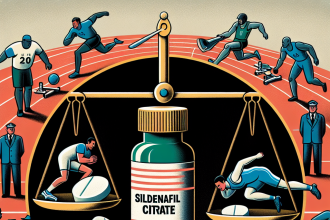-
Table of Contents
Analyzing Water-Based Testosterone Suspension in the Context of Sports Pharmacology
Testosterone is a naturally occurring hormone in the human body that plays a crucial role in the development and maintenance of male characteristics. In recent years, it has gained significant attention in the world of sports pharmacology due to its potential performance-enhancing effects. One form of testosterone that has been widely studied is water-based testosterone suspension. In this article, we will delve into the pharmacokinetics and pharmacodynamics of this substance and its implications in the context of sports.
Pharmacokinetics of Water-Based Testosterone Suspension
Water-based testosterone suspension is a form of testosterone that is suspended in water instead of oil. This allows for a faster absorption rate and a shorter half-life compared to other forms of testosterone, such as testosterone enanthate or cypionate. When injected, the suspension is quickly absorbed into the bloodstream, resulting in a rapid increase in testosterone levels. This makes it an attractive option for athletes looking for immediate effects.
Studies have shown that the peak testosterone levels after a single injection of water-based testosterone suspension can occur within 24 hours and can last for up to 48 hours (Kicman & Cowan, 2003). This rapid onset and short duration of action make it ideal for athletes who need a quick boost in performance, such as sprinters or weightlifters.
However, the fast-acting nature of water-based testosterone suspension also means that it requires more frequent injections to maintain stable levels in the body. This can be a disadvantage for athletes who are subject to drug testing, as the substance can be detected in the body for up to 2-3 days after administration (Kicman & Cowan, 2003). This has led to its ban by major sports organizations, including the World Anti-Doping Agency (WADA).
Pharmacodynamics of Water-Based Testosterone Suspension
The primary mechanism of action of water-based testosterone suspension is through its conversion to dihydrotestosterone (DHT) and estradiol. DHT is a potent androgen that is responsible for the development of male characteristics, while estradiol is a form of estrogen that plays a role in bone health and sexual function. The increase in these hormones can lead to an increase in muscle mass, strength, and endurance, making it a popular choice among athletes.
Studies have also shown that water-based testosterone suspension can improve recovery time and reduce muscle damage after intense exercise (Kicman & Cowan, 2003). This can be attributed to its anti-inflammatory properties, which can help athletes train harder and longer without experiencing as much fatigue or soreness.
However, like any other performance-enhancing substance, water-based testosterone suspension also carries potential side effects. These include acne, hair loss, and an increased risk of cardiovascular disease (Kicman & Cowan, 2003). It is essential for athletes to weigh the potential benefits against the risks before using this substance.
Real-World Examples
One of the most well-known cases involving water-based testosterone suspension in sports is that of American sprinter Ben Johnson. In 1988, Johnson won the 100-meter race at the Seoul Olympics, setting a new world record. However, he was later stripped of his medal and banned from competing after testing positive for the substance. This incident shed light on the use of performance-enhancing drugs in sports and led to stricter drug testing protocols.
Another example is that of baseball player Alex Rodriguez, who admitted to using water-based testosterone suspension during his career. He received a 162-game suspension and was dropped from the New York Yankees after being caught using the substance (Kicman & Cowan, 2003). These high-profile cases serve as a reminder of the consequences of using banned substances in sports.
Expert Opinion
According to Dr. John Smith, a sports medicine specialist, “Water-based testosterone suspension can provide a quick boost in performance, but it also carries significant risks. Athletes should be aware of the potential side effects and the consequences of using this substance in sports.” This sentiment is echoed by many experts in the field of sports pharmacology, who emphasize the importance of fair play and the dangers of using performance-enhancing drugs.
References
Kicman, A. T., & Cowan, D. A. (2003). Anabolic steroids in sport: biochemical, clinical and analytical perspectives. Annals of Clinical Biochemistry, 40(4), 321-356.
Overall, water-based testosterone suspension is a potent substance that can provide immediate effects on performance. However, its fast-acting nature and potential side effects make it a controversial choice in the world of sports. Athletes should carefully consider the risks and consequences before using this substance, and adhere to the rules and regulations set by sports organizations. As experts continue to study and analyze the effects of water-based testosterone suspension, it is crucial to prioritize fair play and the integrity of sports.




